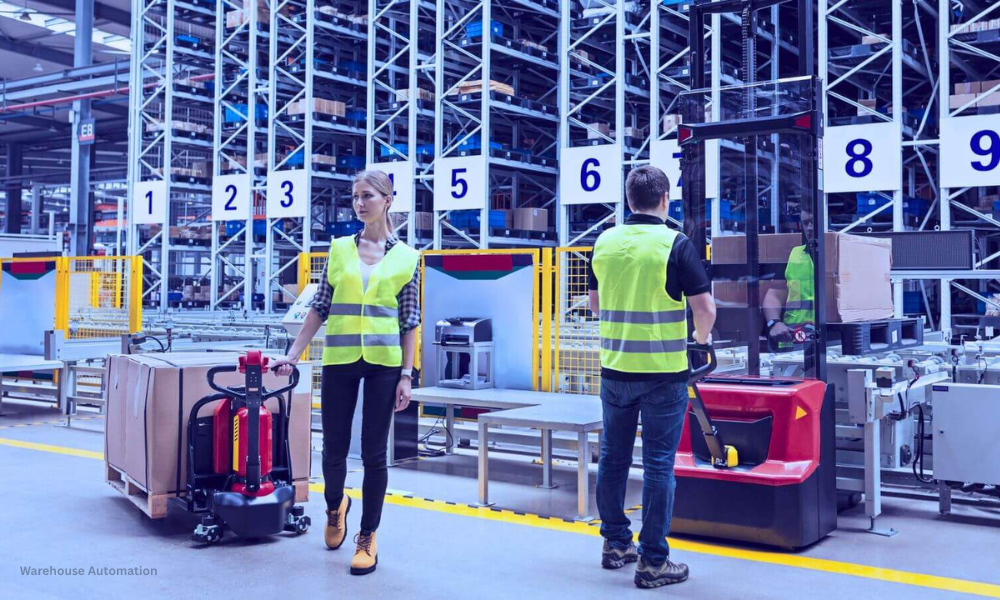Warehouse Automation: Everything You Need to Know

Warehouse Automation
So you’re wondering what warehouse automation is and whether it’s worth the hype? Let’s start with the basics. Warehouse automation refers to the use of technology robots, software, and control systems to perform tasks that were traditionally done by humans. These include storing, retrieving, packaging, and shipping goods.
Why should you care? Because automation is revolutionizing how businesses handle logistics. It’s not just about replacing workers it’s about making your entire warehouse faster, smarter, and more cost-efficient.
Table of Contents
Types of Warehouse Automation Systems
Goods-to-Person (GTP) Technology
GTP systems deliver items directly to human operators using robots or carousels, reducing walking time and boosting speed.
Automated Storage and Retrieval Systems (AS/RS)
These are computer-controlled systems that automatically place and retrieve loads from specific storage locations with precision and minimal effort.
Conveyor Systems
Conveyors move goods efficiently across various warehouse zones—great for high-volume operations.
Autonomous Mobile Robots (AMRs)
AMRs use cameras, sensors, and AI to navigate the warehouse floor independently, offering flexible and scalable automation.
Voice Picking & Pick-to-Light Systems
These systems guide workers through the picking process using voice commands or lights—reducing errors and speeding up order fulfillment.
Key Benefits of Warehouse Automation
Enhanced Efficiency and Productivity
Automation can increase warehouse output by up to 50%—no breaks, no fatigue.
Reduced Labor Costs
Fewer workers are needed for repetitive, time-consuming tasks. It’s not about replacing jobs entirely—it’s about upskilling and reallocating labor.
Improved Accuracy and Inventory Control
Automation reduces picking and packing errors significantly, leading to fewer returns and happier customers.
Increased Safety Standards
Robots handle dangerous tasks, reducing workplace accidents and improving compliance.
Cost of Implementing Warehouse Automation
Initial Investment and Setup
Depending on the size of your facility, costs can range from $100,000 to several million. Consider it a long-term investment.
Maintenance and Operational Expenses
Ongoing maintenance, software updates, and energy consumption add to the cost—but they’re offset by savings and efficiency gains.
ROI of Warehouse Automation
Payback Period Expectations
Most companies start seeing ROI within 2–5 years, depending on the level of automation and workflow complexity.
Real-life Success Stories
Companies like Amazon and Alibaba have slashed order processing times and reduced labor reliance through full-scale automation.
Challenges and Risks
Integration with Legacy Systems
One of the biggest hurdles is integrating new automation tech with outdated software or manual processes.
Workforce Resistance and Job Displacement
There can be pushback from employees. A smooth transition requires training and clear communication.
Downtime and Technical Failures
Machines break down. That’s why having contingency plans and strong vendor support is crucial.
Steps to Automate Your Warehouse
Assess Your Needs and Objectives
Not every warehouse needs full automation. Start by analyzing your workflow bottlenecks.
Choose the Right Technology
Whether it’s AMRs or GTP systems, choose solutions tailored to your operations.
Pilot and Scale
Test automation on a small scale before rolling it out across the entire warehouse.
How Warehouse Automation is Transforming E-commerce
Faster Fulfillment and Reduced Returns
Automated warehouses fulfill orders faster and more accurately—crucial in the age of Amazon Prime.
Improved Customer Experience
Faster deliveries and fewer errors = happier customers and stronger brand loyalty.
Top Companies Offering Warehouse Automation Solutions
Amazon Robotics
Known for its fleet of Kiva robots, Amazon leads the charge in robotic warehousing.
Swisslog
Swisslog specializes in AS/RS and GTP systems that scale with your business.
GreyOrange
GreyOrange combines AI and robotics to create flexible fulfillment systems.
Dematic
A global player offering comprehensive warehouse automation—from conveyors to software integration.
Future Trends in Warehouse Automation
AI-Powered Optimization
AI helps forecast demand, manage inventory, and optimize robotic workflows.
Warehouse Drones
Drones may soon handle inventory audits and light item retrievals.
Integration with IoT
IoT-enabled devices will further connect systems, creating a truly smart warehouse.
Warehouse Automation vs. Manual Warehousing
Efficiency and Throughput Comparison
Automation crushes manual operations in speed, precision, and uptime.
Cost Analysis Over Time
Though expensive upfront, automation saves you money in the long haul.
Compliance and Security in Automated Warehouses
Data Protection and System Security
Secure software systems are essential to prevent breaches and data loss.
Regulatory Considerations
Automated systems must meet local labor, safety, and environmental standards.
Sustainable Warehouse Automation
Energy-efficient Systems
Modern robotics are designed with power-saving features.
Waste Reduction and Smart Packaging
Automation supports eco-friendly practices through precision and less packaging waste.
Final Thoughts on Warehouse Automation
Warehouse automation isn’t a futuristic luxury it’s a necessity for any business serious about scaling efficiently. From reducing costs and increasing output to boosting customer satisfaction, it’s a game-changer across industries. Start small, scale smart, and make your warehouse future-ready.
FAQs
Is warehouse automation suitable for small businesses?
Yes! Even basic tools like barcode scanners or simple conveyor belts can significantly improve efficiency.
How long does it take to fully automate a warehouse?
Anywhere from a few months to over a year, depending on warehouse size and automation scope.
Will automation eliminate warehouse jobs?
Not entirely. It shifts human roles to more skilled tasks while handling repetitive work.
Can I integrate warehouse automation with my existing ERP system?
Absolutely. Most automation providers offer integration with major ERP platforms.
What’s the biggest challenge in warehouse automation?
Integration with current systems and managing change among staff are the most common hurdles.






